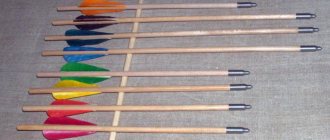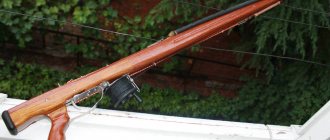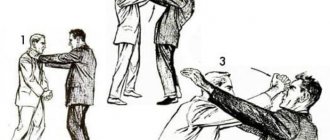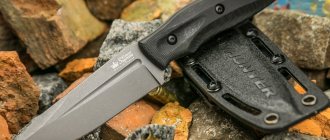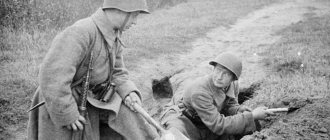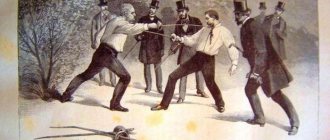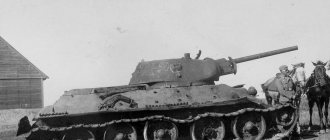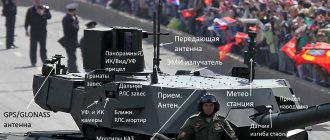Crossbow arrows or bolts are purchased strictly for a specific type of weapon. When purchasing a foreign-made boom, American or European, you need to know that they only come in 21 and 22 inches. And most crossbows require 16-inch projectiles. It is recommended to purchase crossbow arrows of the correct size. This will significantly save your budget.
Crossbow arrows.
Ballistics of crossbow arrows
There are two main factors influencing ballistics - the weight and stiffness of the arrow (of course, provided that the arrows themselves are straight).
Everything is clear with the first one, since it is reflected in the fundamental formula E = mv2/2. That is, both speed and energy depend on the mass of the projectile. All this significantly affects the flight trajectory, and therefore the accuracy of the hit, the calculation of aiming corrections, the firing range, etc. It doesn’t matter whether it’s a bow, a crossbow or a rifle. This is what the real speed indicators of one crossbow with original and GOST shoulders look like for various arrows:
| Crossbow model/tension, lbs | Initial speed fps / m.s., with arrow weight (average value over 3 shots) | |||||||||
| 390 grains | 408 grains | 433 grains | 450 grains | 470 grains | 485 grains | 500 grains | 565 grains | 590 grains | ||
| "Archon" | 200 lbs/91 kgf | 369,9 / 112,8 | 360,6 / 109,9 | 350,9 / 106,9 | 344,7 / 105,0 | 337,3 / 102,8 | 330,8 / 100,8 | 329,4 / 100,4 | 312,1 / 95,1 | 306,4 / 93,4 |
| "Archon" | 95 lbs/43 kgf | 267,4 / 81,5 | 259,2 / 79,0 | 253,0 / 77,1 | 249,0 / 75,9 | 244,7 / 74,6 | 240,2 / 73,2 | 239,3 / 72,9 | 226,8 / 69,1 | 221,9 / 67,6 |
Necessary explanations for crossbow-bow units of measurement:
1 Lbs (lb) = 0.45 kg
1 grain = 0.0648 grams
1 fps (feet per second) = 0.305 m/s
The issues of dependence of arrow speeds on the types of arms and other factors are discussed in more detail in the article “Powerful crossbow - what kind of animal is this?”
For uniform ballistics and, therefore, high accuracy, all your arrows should be the same. Uniformity will also help avoid additional shooting. With an average weight of an arrow with a tip of about 25 grams (390 grain), we are talking about tenths of a gram. Almost any household electronic scale can easily cope with such measurement accuracy.
Much more difficult with rigidity. An arrow is not a bullet; in flight it wriggles like a snake. This phenomenon is called the “arrow paradox” and is often played out in Korean and Chinese historical action films, when on the screen in slow motion arrows manage to cleverly go around “their own” and hit the enemy. We will dwell on it in detail in the article about archery arrows, since it is difficult to do without adjusting the rigidity (“spine”) to a specific bow. “Spine” is the amount of arrow deflection in fractions of an inch. For example, with a spine of 400, the value is 0.400 inches (2.54 cm).
In short, the spine measurement technique looks like this:
The load must be a certain weight (880 g), the boom must be 29 inches long, etc. The smaller the “spine” - the amount of deflection of the arrow - the stiffer it is. The length of the arrow, the weight of the tip and shank, the strength of the bow, and much more are also taken into account.
For a crossbow, this factor is not so significant. The fact is that a crossbow arrow is much shorter than a bow arrow and in any case, even with relatively thin walls of the “tube”, will be stiffer (archers cut the tubes to increase rigidity). In addition, unlike any bow, it moves along a guide groove. And yet, “spine” cannot be completely discounted. Simply put, the more powerful the crossbow, the stiffer the arrows should be. And the larger the animal you are going to hunt, too. As, by the way, is the total mass of the arrow with a combat tip, even if the speed decreases slightly.
We are only interested in uniformity in rigidity. The simplest and only way is to purchase arrows from well-known manufacturers and not bother with anything else. Moreover, for them, the “firms” always indicate both the mass and the “spine”. It is very difficult to correctly measure the spine of a short crossbow arrow at home; you can bend it or break it.
As for the material. These are fiberglass, aluminum and carbon. We won’t consider the first one at all – well, to hell with it. When choosing expensive branded arrows, there is no particular difference - whether they are aluminum or carbon. Among cheap products from Southeast Asia, it is better to choose carbon. I’m not an expert in the Technology of Structural Materials, but I think that carbon in production is more technologically advanced and makes it possible to achieve better performance at lower costs.
In general, it wouldn’t hurt to have a special machine to detect the curvature of arrows and defects in tips. It costs about the same as one good assembled hunting arrow.
Finally, we move on to the arrows themselves. Let's start with the entertainment and recreation segment.
Ballistic characteristics
When choosing ammunition, you should pay attention to its weight.
- The speed and energy of flight depends on it.
- Frequent use of heavy arrows causes rapid wear of the bowstring.
Types and purpose of arrows. - The lungs, due to differences in energy parameters and shock loads exceeding its capabilities, will affect the operation of the moving mechanisms and the crossbow bowstring.
- Shells for compound crossbows weigh 400-425 g, recurve and pistol crossbows - 350-400 g. Carbon or aluminum ammunition is quite flexible and maintains excellent balance. Shanks can be crescent shaped or flat.
- Rigidity is also the main criterion when choosing. It must match the weapon model. It is important to select the same consumables for the crossbow.
Ammunition for hunting
Of course, crossbow arrows for hunting must be heavy. The range of variations is quite wide. Some specimens can reach almost 13 g. This refers to the weight of the tip. The hunting shells themselves can be divided into three types: multi-bladed, with drop-down blades, and shockers. Moreover, each tip has certain features. Multi-blade ones have from 2 to 4 blades. But the best choice is a tip with three fragments - this is already for big game. Suitable for wild boar too. A crossbow arrow with drop-down blades is intended purely for amateurs. The affected area, of course, is wider and the flight path is more stable, but there is also a negative factor - when the blades open, the energy or power of the arrow is extinguished, losing almost 30 or 15% of the initial one. This is not exactly what is needed for hunting large game, but for medium game it will be optimal. Shockers – designed for birds and other small game.
Recently, crossbow shooting has become more popular and accessible. This exciting activity trains not only patience, eye and concentration, but also teaches discipline. There is only one wish: that there be more shooting ranges equipped for crossbow shooting.
How to make an arrow for a crossbow
You can make your own ammunition.
- Hardwood and duralumin tubes are suitable for making a shaft.
- The tip can be cap, sleeve or mortise.
- For plumage, plastic or natural feathers are used.
For step-by-step production, it is better to use the instructions.
What material should darts and arrows be made of?
Currently, there are no perfect arrows that can last a long time and remain in perfect working condition. Each type, depending on the material of manufacture and application, has its own disadvantages:
- Carbon arrows for crossbows are the most popular, but when shooting at hard targets, microcracks form on them.
Wooden arrows. - Aluminum alloy is less expensive, however, after a couple of shots the arrows become deformed.
- Fiberglass is a budget option, used only on low-power weapons.
- Wood - high cost, fragile, require special storage conditions, short flight range.
- Fiberglass - low price, but short service life.
The material used to make ammunition is directly related to the purpose of use. Carbon arrows are recommended for big game hunting. Fiberglass and aluminum arrows are more suitable for pistol crossbows and sport shooting at soft targets.
Which tips are suitable?
Tips with high penetrating power and lethality are suitable for hunting. Tips made from cheap materials should not be used for hunting. It is advisable to take with you different types of points:
- solid, with a fixed point;
- streamlined, open when hitting an animal;
- with blunt tips - shockers, do not spoil the skin of the prey.
The tip on hunting arrows is a set of sharp blades.
- The most popular are three-bladed tips.
- When an animal is hit with such ammunition, it experiences profuse blood loss.
- However, the blades should not be very large, as this will affect the shooting accuracy.
Hunting arrows for crossbow.
When going hunting for large game, it is recommended to take a tip with a fixed knife-shaped blade. You can sharpen it yourself at home.
For more accurate shooting, it is better to use mini-tips with a fixed blade. Since they are more penetrating, they are stable in flight and do not get stuck in the bones and skin of animals. For small game and birds, it is better to take a shocker tip. Its blades are similar to the legs of an insect.
Homemade arrowheads: characteristics
Regardless of the task, the arrow tip must have the following characteristics:
- To hit the target, homemade tips must be sharp.
- For high destructive properties they must be durable.
- To ensure good aerodynamic qualities, they must be moderately heavy, as well as streamlined in shape.
- The material for making nozzles must be durable, but at the same time easy to process.
In addition, to effectively achieve your goals, all arrows must have the same tips, which must be equal in weight
This is especially important for arrows used when shooting from a crossbow.
Arrows for hunting
Again, I suggest you first look at the article “Hunting with a bow and crossbow - is it possible or not?” And estimate the size of the financial costs, based on the fact that only one hunting arrow complete with tip will cost five to six thousand.
If we are talking about animal hunting, then the novice crossbowman has two options.
First: without further ado, purchase any overseas or “Easton” arrows 20 or 22 inches with a spine no higher than 400, weighing about 350 grains/22-25 grams without a tip.
Please note that in some cases you will have to assemble the arrow yourself. That is, purchase separately the tube itself, the shank, the insert sleeve and pick up a tube of glue. Then select tips for them from one of the leading companies 100-150 grains (7-10 grams). To avoid any illusions, I report that one of these costs 4-5 thousand rubles.
But their choice is a completely separate conversation (see “Hunting a wild boar with a crossbow”), everything will depend on the type, age and size of the intended prey, distances and shooting conditions, as well as the characteristics of the crossbow.
The second option, cloth-cut, is extremely undesirable, but much cheaper. We buy budget carbon arrows 20-22” and carry out all the manipulations outlined in the previous chapter, selecting the five most worthy specimens. But the main savings will be elsewhere. Using the method of searching for arrows from the same chapter, we look for and find broadheads or mechanical “openers” from not so famous manufacturers (pictured). They will be several times cheaper than elite overseas ones.
In the most careful way - into a special target shield! – we shoot the crossbow with our arrows. We select those that will show the best accuracy and calm down, since we still can’t change anything else. The blades of very cheap tips are, frankly speaking, disposable, but often replaceable. That is, your reserve should be enough for several exits. Especially if there are no hits on the bone, for example, in the shoulder blade of an animal or when hunting for a feather (“With a crossbow on a black grouse”).
Before purchasing, I advise you to get acquainted with some of the nuances associated with the use of this kind of components in the article “Where to shoot with a bow and crossbow?”.
Necessary clarification. In articles, and in practice, I always try to choose the most budget option for entertainment use, the optimal one in terms of “price/quality” criterion. For serious purposes and tasks, on the contrary, I recommend using exclusively high-quality accessories and ammunition, for example, pneumatic bullets made in Germany and the Czech Republic. But in the case of cheap arrows and tips, an exception had to be made. The article “Homemade Bow for Hunting and Travel” presents several methods for making arrows and tips from scrap materials in “field” conditions. So, no matter how sophisticated we are, home-made ammunition in terms of characteristics will be completely inferior to the most unassuming factory analogues from Southeast Asia.
Let's finish the story for now. If there are any questions or new information, I will add to it.
Hunting and sporting arrows for crossbows
The type of arrow largely determines such parameters as accuracy, accuracy and range of the crossbow. For each specific crossbow model, you should select the appropriate type of arrows. In addition, the durability and trouble-free functionality of the crossbow's throwing equipment depends on the correct choice of arrows. Ammo for crossbows differs significantly from arrows for bows, whether recurve models or more powerful compound bows. Crossbow arrows are shorter and stiffer than bow arrows and exhibit the greatest accuracy and stability in flight.
The influence of arrow characteristics on accuracy and firing range.
An important parameter when choosing ammunition for a crossbow is the weight of the arrow (bolt). Arrows that are too light will quickly damage the moving mechanisms and bowstring of a crossbow, since the energy parameters and impact load in this case are many times greater than the capabilities of the ammunition. Arrows that are too heavy will accelerate wear on the bowstring (ropes) and fatigue on the crossbow's shoulders.
Unscrupulous sellers offer supposedly “licensed” Chinese products for branded crossbows of the brands Excalibur, Hoyt, Barnett, etc. However, we should not forget that the slightest deviation from the characteristics recommended by the manufacturer will lead to the failure of expensive weapons. In addition, the quality of shooting with such ammunition leaves much to be desired, and if you miss while hunting or exciting games, you only have yourself to blame.
In order not to be disappointed in this interesting hobby, we recommend purchasing ammunition produced by world brands:
- Easton
- Interloper
- Carbon Express
By purchasing branded products, the owner of a crossbow can be sure that all the ammunition he uses will be of the same weight, length and rigidity, with the appropriate fletching and correct balancing.
Depending on the materials, technologies and purpose used for manufacturing, crossbow ammunition is divided into certain types and has its own advantages and disadvantages:
- Carbon arrows are the most popular, but over time they become covered with microcracks when carelessly shooting at hard targets. Therefore, it is recommended to use less expensive ammunition for training, and carbon only for hunting or competitions.
- Arrows made of aluminum alloy are in second position in terms of cost. The main disadvantage of this ammunition is that it becomes deformed after several shots. Recommended for hunting (with new arrows) or for shooting at regular and 3D targets.
- Fiberglass arrows are cheap, budget-friendly crossbow ammunition. They are used only on low-power weapons, since they are too light and can damage the bowstring, cables (for block crossbows) and weapon mechanisms.
Also, crossbow ammunition is divided into two main groups:
- Sports arrows are usually tubular (hollow) products with the lowest possible weight, making them the fastest and longest-range. Used for sport and recreational shooting.
- Hunting arrows are produced only as solid cast arrows, since they must be 2 times heavier than sports arrows in order to provide the greatest impact force to inflict a mortal wound on the animal. In this case, the flight range fades into the background.
How to Choose the Right Ammo for Effective Hunting
Big game can only be hit with a heavy carbon arrow - it is an extremely durable, highly effective ammo with perfect balance and geometry and thickness along its entire length. Often, on crossbow ammunition intended for hunting, the front section of the shaft is equipped with a threaded insert onto which you can screw a tip appropriate for the intended purpose - sporting or hunting.
Fletching used for hunting and sporting arrows
Carbon ammunition for hunting any animal, be it a hare or a bear, is always equipped with a longer tail than for sport shooting. The fact is that effective hunting of a large animal can only be achieved from a distance of no more than 30 meters to the target. Thus, an arrow fired from a crossbow must stabilize within the first 5-10 meters and take a combat course in order to hit the target to death.
Aluminum and fiberglass ammunition are more suitable for training and sports shooting at “soft” targets. But with them you can hunt birds and small animals well. These arrows are shorter and less heavy than carbon arrows for big game. The length of such ammunition is up to 30 cm, weight +/– 25 grams.
Tips for hunting and sporting ammunition
For hunting, it is necessary to use tips with sufficient penetrating power and high lethality. For 100% lethal defeat of an animal, different types of tips are used, depending on the size and weight of the expected game.
There are three main categories of hunting tips:
- Shockers with a blunt tip that prevents penetration and damage to the skin,
- Streamlined, with blades opening in the body of the beast,
- All-alloy with fixed blades.
Experienced hunters carry sets of ammunition with various types of tips for hunting any animal.
Criterias of choice
Almost all buyers think about how to choose a crossbow for hunting. The most important characteristics of various crossbow models include the following criteria.
Power
How to choose a crossbow for hunting based on its power? To hunt small animals, an indicator of 47 kg/s will be enough. But for a roe deer such power may no longer be enough. To successfully hunt a deer, the tension force must be at least 60 kg/s.
Weight
Hunting with a crossbow should not take much effort from a person. The optimal weight of the weapon depends on your physical capabilities. Learn that heavy weapons will be much more difficult to shoot.
dimensions
Select the dimensions of the model based on their specific storage conditions. Think in advance about how you will carry your weapon while hunting.
Material
Most often, the stock is made of aluminum. More expensive models are equipped with a stock made of composite materials. The butt can be either wooden or plastic.
Presence of a fuse
They can be installed for both right and left hands. It all depends on the individual preferences of the person. Hunting with a crossbow requires the owner to be a professional weapon owner.
Weaver plank
It serves to fix the sight. In most modern models, this option is included in the basic package. The sight itself is equipped with illumination.
Blank shot protection
This function is one of the most important in a crossbow. In case of an accidental blank shot, the shoulders may not be able to withstand the load. There is a high probability that they will simply break. In this case, the weapon will lose its functionality.
Price
How to choose a crossbow if you want to save money? A high price does not guarantee that the selected item has high combat characteristics. The cost largely depends on the brand. However, not all hunters are willing to overpay for a big name.
The manufacturer sets the price based on many factors. These include the quality of the material and the work on the design of the butt. People are often mistaken when they see a sign that a crossbow is made in the USA. In fact, most of the production facilities of large companies have been operating in China for a long time. Some of them are located in Taiwan.
Selection rules
Before purchasing a crossbow, it is recommended to familiarize yourself with the supplier market and read reviews from owners. It may not be easy to purchase components for the selected weapon model in the future: shanks, tails, tips. Replacing worn parts yourself will save your budget.
Having purchased products from one company and getting used to them, shooters reluctantly change them. Well-known brands of consumables:
- Torrid SS;
- Cold Steel;
- Nap Bloodrunner;
- Carbon Express Mayhem;
- Crimson Talon;
- Easton Archery.
You should be careful when choosing a product and not purchase supposedly “licensed” products. A small error can lead to damage to the weapon.
Crossbow power
The destructive power of modern guns has different meanings. Much depends on the model of the product, the weight of the projectile, the type of tip, distance and other factors. Power directly depends on the tension of the arms and, of course, the initial speed of the arrow fired from the crossbow. Shooting has its own characteristics. Here the concept of a “direct shot”, which is inherent in firearms, cannot be applied. This is due to the relatively low initial speed of the bolt compared to the bullet. Therefore, the trajectory of a crossbow projectile is specific. When zeroing, one no longer focuses on distance, but on the type of projectile. It would be more correct to use the concept of “effective firing distance” - a parameter of the distance of guaranteed target destruction. Usually this is 100 - 10 meters.
Machine for detecting arrow curvature and tip defects
It is almost impossible to determine the straightness of archery and crossbow arrows by eye. Sometimes they rolled them on glass and did other amateur activities. But in cheap Chinese products, not only the arrow may be crooked, but also, for example, the thread for the tip. And it itself may be damaged.
Created according to the same principle, fairly simple devices with rollers along the edges flawlessly detect any runout. The first photo shows an example of a homemade machine, which the author (colleague of Mr. BUR) called “Inspector”.
Naturally, there are industrial analogues like the “Pine Ridge Arrow Inspector” (photo below).
The cost of such equipment is approximately the same as a good assembled arrow; branded models, of course, are more expensive..
Using them is very simple: we place the arrow with the tip, as shown in the picture, and scroll it. Any flaws will come out instantly. But they directly affect the accuracy of the shot.
In theory, there shouldn’t be any questions, but there are still some nuances. Below I have attached a video, just from Mr. BU R.
So, all attention to the very tip of the tip. As you can see, it practically remains in one place, moving slightly only horizontally (this already depends on our accuracy when unwinding the arrow)
This is how it should be.
In this case, we get the ideal “arrow-tip” complex, even now for hunting! But it may happen that runout is detected, therefore, both components need to be checked. We just unscrew the tip and replace it with another one - the beating has disappeared, which means the culprit has been found; if it remains, we change the shaft. Well, if there are flaws in any combination, then the best option is to throw the “projectile” in the trash. Or leave it for friendly shooting “towards the target”.
Posted in For bows and crossbows | Tags: selection of arrows, for a crossbow, arrowheads for arrows, hunting arrows, arrows for a crossbow, arrows for a bow, arrows for hunting, archery |
arbalet-airgun
Wild boar is the main type of prey for a crossbowman who decides to engage in animal hunting. All kinds of deer, popular on the American continent, are not so common here, although they can also become quite legal prey (see “Hunting with a bow and crossbow - is it possible or not?”).
The article “Crossbow for game hunting” was devoted to the choice of weapons for large animals; now it’s up to its use. I would like to emphasize that this description is nothing more than a diagram of some ideal hunt for a beginner. Reality may differ radically from it, both for the better and for the worse. Let's literally briefly consider purely biological issues - you can read them in detail in any article about wild boars - let's focus on the wild pig exclusively as an object of hunting.
Who should you not shoot at?
First, about those whom we will not shoot arrows at under any circumstances.
First of all, this is a female with piglets.
Comments seem to be unnecessary. However, the widespread belief that females and piglets are not shot at all is also erroneous. And there is an overabundance of pigs on the land, and there are defective piglets. As a rule, crossbreeds with domestic pigs are culled, which does not happen very rarely (pictured).
The modern domestic sow hare is essentially an unfortunate creature, something like a bodybuilder abusing steroids - an artificially created biomass on legs, due to the lack of immunity, living on antibiotic injections. To prevent such a monstrously mutated genotype from spreading throughout the forest wild boar population, selective shooting is carried out - when the piglets reach gastronomic standards, but before the onset of puberty.
In any case, the huntsman will clearly set priorities before the hunt: when, whom and how many.
The second taboo option is an adult wild boar, also known as a cleaver, or a wild boar, that is, a seasoned male with mature “cutting” fangs.
Weighing sometimes a quarter of a ton, the living tank is the northern analogue of the rhinoceros, whose poor eyesight, as we know, is absolutely not its problem. Moreover, just in time for the hunting season, the cleaver begins to acquire the so-called “kalkan” - completely impenetrable armor made of overgrown connective tissue in the neck and chest, complemented by a solid frozen wool tangle for winter. Kalkan, as luck would have it, covers exactly the killing zone of the boar, and not even every bullet can take it.
Add to this the natural power of the beast: a high pain threshold, an exorbitant level of endurance and “vitality” in general. A huge elk lies down from a wound that will only enrage the boar. In ancient times, it was a manifestation of valor for any warrior to defeat one, naturally, from a horse and a heavy spear. And at the same time stay alive.
Even now, with the exception of trophy hunting, the cleaver is caught relatively rarely, and not at all because of fear of it, but because it is he who is the main producer of offspring. They shoot mostly shaggy monsters that have already lost their minds, who are interested not so much in females as in the opportunity to once again rip open the side of a relatively young opponent. As with all higher mammals, including primates, in the boar world everything is ruled exclusively by powerful male warriors.
Fortunately, seasoned loppers are extremely unsociable and visit their brethren clustered in herds only during the rutting season. In open spaces they also do not like to glow, except at night. It is at this time of day that the most experienced hunters (with powerful firearms and belaying comrades, of course) take the boar fattening in the fields from the approach. An arrow with almost no stopping effect would only become an additional irritant for him.
We will also not shoot at any moving boar. But more on this below, when we begin to consider hunting methods.
Who will we hunt?
So, relatively young individuals, usually male, remained as the main objects of crossbow hunting.
This prey is all the more attractive because the nutritional value of meat deteriorates with age, and the taste changes greatly. Moreover, the danger of trichinosis sharply increases - that nasty thing, very painful and difficult to treat. Moreover, the larvae can easily withstand any heat treatment.
From a gastronomic point of view, the best option is a youngster, that is, a piglet of the current year of birth and a little older.
You can see him right away - all so neat, orderly, still without a hump, but no longer a milky minke whale. With difficult to distinguish gender. They are slightly lighter in color than adults and more ankle-length. They weigh from 25 to about 40 kilograms.
The so-called gilts - boars one and a half to two years old - are much more respectable guys, weigh 60-70 kilograms and look the part. The withers are already visible, and real stubble is appearing.
At this age, it is still very easy to confuse a pig with a pig.
Over time, sexual dimorphism develops, and an adult boar is quite easy to distinguish from a female by its silhouette.
The cleaver, so to speak, has a much more developed shoulder girdle, and a much more massive head. Now attention: you have just passed a kind of test.
If you were touched by the above photographs and were offended by the text commenting on them, do not read further. And put aside the thought of hunting. There is a sea of its own specifics, which are not always understandable and pleasant for outsiders. You will only exhaust yourself and your first prey, which will most likely be your last. This concludes the short course in “wild boar studies” and moves on to the actual hunting. The first in our crossbowman career. Most likely, it will take place either in an enclosure or in the hunting grounds of the country where this is permitted. By the way, the so-called An “aviary” is by no means a pen for deer and wild boars, but full-fledged land, sometimes of a huge area, only with a different legal status. In them, animals are not the object of hunting, and therefore, methods of killing them are not regulated by hunting legislation.
Current insert.
No sooner had this article been published than the first comment appeared, roughly in the following vein: “The article is stupid - some additional shooting, connections with some huntsmen, hunter ethics and other crap. We need clear and precise instructions on how a tenth grader who bought a crossbow can go into the forest and kill a wild boar.”
Especially for my critic and his comrades in spirit: when it comes down to it, a successful poacher is the most experienced hunter. Or a fisherman. Or both at the same time. You cannot become one by reading articles or posts on thematic forums, without starting with the basics of practice, preferably by learning from someone more knowledgeable. It’s the same as building your life according to the precepts of the wonderful book “How to become a criminal “authority” in 10 lessons.” A manual for suckers."
Methods of hunting wild boar with a crossbow
Its main types are inaccessible to us due to the low speed of the arrow. It is impossible to calculate the lead when shooting at animals rushing past the shooter “at number” during a drive. Hunting with dogs is unsafe, first of all, for themselves, who are capable of instantly running under a seemingly leisurely projectile fired at a wild boar.
What remains is a static ambush hunt. Mainly from a tower, an outpost, a storage shed, including a mobile one - the so-called tristand.
And not only for the safety of the shooter. Over millions of years, wild boars, as well as bears, have developed the ability, which is extremely useful for hunters, not to pay attention to what is happening above their heads. And really, who would dare to jump from a branch onto their neck? Unless it's Rambo from First Blood.
Hence the first rule of preparing for crossbow hunting: do not get carried away with shooting at classic paper archery targets, spend more time on three-dimensional ones. And get acquainted with the information contained in the article “Where to shoot with a bow and crossbow?”.
3D targets allow you to completely simulate shooting at real animals from different angles, both horizontally and vertically. And it is quite different from a shot “on paper”.
Ideally, preparation for a hunt should look like this.
You are already confidently shooting at 3D targets depicting a wild boar at your dacha, both in profile, which is easier, and in “three-quarter” view (see “3D targets for bows and crossbows”). And yet, when going to a hunting area, take at least one of these with you. Having arrived at the place, go with the huntsman to the feeding area with a tower and from there measure the entire hunting area with a rangefinder using more or less noticeable landmarks. Then, by placing the target sequentially at all these landmarks, determine in practice what corrections you will have to make when shooting. Let me remind you that your crossbow should already be zeroed in advance at all distances divisible by 10 meters, starting from 20 and up to 50-60 meters (for details, see the article “Installing and zeroing an optical sight”).
It looks something like this:
You will notice how your aiming adjustments will change compared to how you are used to shooting horizontally. Therefore, it is highly desirable to organize training and entertainment shoot-outs not only on the lawn, but also, say, from the balcony of a country attic (which is unsafe) or in an abandoned quarry.
Consider yourself ready to hunt only when 90 percent of the arrows fired from the tower at different distances land in the killing zone of the target. A huntsman or an enclosure hunting farm worker will also carefully observe your actions and will definitely draw conclusions for himself. For example, about how likely it will be for a wounded man to come after you - of course, not free. And even about whether you should be allowed to hunt at all, even though you paid for it.
You will have to spend a fair amount one way or another. The cost of an enclosure hunt or a commercial voucher (which is basically the same thing) for a wild boar amounts to tens of thousands of rubles. Therefore, especially do not skimp on accessories.
Selection of arrows, tips and hunting accessories
Tips . Don't be tempted by cheap "tinny broadheads" like the OZ, focus on the famous ones or the "G5 Outdoor" (pictured "G5 Striker Magnum").
But be careful here too. In the bottom picture on the left is the original “G5 Montec CS”, on the right is a one-off Asian “copy” under the same name
This is by no means a disdain for oriental goods, miracles simply do not happen, and the difference in price by an order of magnitude did not arise by chance. For that matter, you know very well WHERE most complex technical products are now produced, regardless of brand, and China has now become a leading steelmaking power. We are talking about “nameless” products from equally faceless enterprises, or, even worse, about blatant counterfeit goods. The best cure for following the “cheap and cheerful” principle is to buy a normal tip and a consumer goods product, followed by an objective comparison of them in practice. After all, it’s not customary for us to learn from other people’s mistakes.
Extremely undesirable, but having a right to exist, a budget option is also possible. Below in the text is a link to an article about choosing arrows. It is discussed in sufficient detail.
For hunting large wild boars, you can use 2-bladed tips, with which the guarantee of penetration will be slightly higher, although blood loss from a non-through wound, on the contrary, is lower due to the reduced area of tissue damage.
Tips with blades that open upon contact with the body are preferable to use on other, not so “thick-skinned” ungulates, such as roe deer or other deer (see “Hunting with a crossbow for deer by stealth”). Maybe for a young piglet.
The approach to choosing arrows is similar: only time-tested, well-known models from leading manufacturers. As a rule, these are Easton and Carbon Express products. For example, “EASTON BloodLine carbon” - at 20″ or 22″, with a mass of 10.5 grains per inch. When paired with a 100 or 125 grain high quality point, this will be a very fast and accurate projectile.
The story with the tips repeats itself here. Yes, products from Southeast Asia are cheap, accessible and quite suitable for country house and entertaining shoots. But it is no coincidence that in sports it is customary to carefully weigh and evaluate even exclusive arrows by their “spine” before selection. According to these indicators, cheap shells, even from the same batch, differ greatly from each other, which means they fly differently. Imagine how this could end on a wild animal hunt. Plus, or rather, minus - possible flaws, such as oblique plumage or crooked threads for the tip. As an option, a thorough check of budget arrows upon purchase (again, not the cheapest in the range) up to weighing without tips on electronic scales you take with you. Read more in the article “Arrows for crossbows”.
I also strongly recommend purchasing and equipping your arrows with tracer shanks (“heels”).
Some craftsmen make them themselves, using chemiluminescent components or LEDs.
Read more about their use below, when we move on to hunting.
Remember that sighting should be carried out with the same arrows and tips with which you will hunt.
Range finder . Either a professional military man or a surveyor can do without it. For a slow crossbow arrow, not even every ten, but every five meters of distance matters. But this same property also gives us an unexpected plus: since we are talking about short distances and far from extreme hunting conditions, relatively cheap models are quite sufficient - there are some even in the region of 10 thousand rubles (pictured below).
For reference: a professional (and there are no others) 50-meter measuring tape will also cost a pretty penny.
Fortunately, most full-size hunting crossbows are already equipped with optical sights with the original reticle . According to their characteristics, they are quite suitable for our purposes. In a different situation, follow the advice on choosing a sight from the article “Sight for a crossbow“.
But you may need not just optics, but a night sight . Wild boars usually go out to feed at dusk, or even at night. With the exception of farms where hunting is relatively rare and the animals are not scared. And here the crossbow has a significant advantage not only in comparison with a bow, where you can’t stick a “night light”, but also with a firearm.
The fact is that due to virtually no recoil on a crossbow, you can use NVGs of the 1st generation, which cannot withstand a shot from a carbine, much less a gun. These cost several times less than devices of generation 2 and 2+, and with the 3rd they differ by an order of magnitude. These are, in particular, sights of the Vologda Optical-Mechanical Association (VOMZ), produced under the PNS brand (in the photo “PNS 2.5x50”). The brackets for them can be selected for any type of fastening.
Vologda residents also have NVDs of the conditional generation “1+” with a ceramic bulb (“PNS 3×50”). They are literally several thousand more expensive, but they are already resistant to serious recoil and work reliably at distances of 100 meters or more.
Read more about them in the article “PNS night sights produced by VOMZ“.
There is one nuance in the use of “night lights”. They are intended mainly for direct shooting distances from firearms (for rifles up to 150-200 meters) - it is night after all. That is, there is no time and no need to work particularly hard on introducing amendments. Therefore, the aiming reticle is simplified - “cross” or “pike”. Crossbows do not have a “direct shot” as such. This means that you will either have to choose a sight with a cross-shaped “mildot” reticle (VOMZ also has these), or shoot from a tower during the day, say, at 40 meters, and then wait until at night the hog approaches any landmark located at this distance.
Although using a simple “duplex” cross it is quite possible to zero in at least a couple of distances:
As for hunting using an under-barrel flashlight , it differs little from rifle hunting. Is it even more difficult, again due to the characteristics of the flight path of slow crossbow arrows. There is too little time for aiming from the flash to the scattering of the “targets” in different directions. Therefore, it is not entirely correct to recommend it to a beginner. Only regular training will help here.
So, we have almost completed all the preparatory activities. It's time to finally move on to the hunt itself.
Attention! If the article breaks off at this point, temporarily disable your ad blocker. Some of them manage to cut off the actual advertising screensavers along with the rest of the text. Moreover, they block the viewing of videos with stories about weapons, scenes of shooting or hunting.
Aim and shoot: secrets of wild boar hunting
In the evening, the huntsman will take you to the tower/storage area, where you will immediately arrange a connection. Now all that remains is to sit and wait, having everything you need at hand and loading the crossbow. At the same time, do not make noise, do not drink, do not smoke, and do not husk seeds. And so on for many hours - the herd may well show up in the morning.
Finally, first the piglets will begin to appear on the feeding area (they still don’t really know how to be afraid), then their older relatives. After some time, a relatively young cleaver may also approach, who will almost certainly disperse all the small things in order to dine alone. It all depends on the instructions given to you by the huntsman - who to shoot. Depending on this, you will select a target and track – through the sight – all its movements. When the hog is in the most favorable position for shooting (preferably in profile), at a clearly defined distance, carefully aim and press the trigger.
How and where to aim.
The aiming itself goes something like this:
in the photo - a distance of 20 meters...
...and now – 30 meters.
Attention: both pictures are just “approximate”, more suitable for the realities of firearms. Based on experience, I recommend moving the aiming point down, in this case (depending on the size of the animal) by ten centimeters - the arrow is not a bullet, the damage to the “liver” is insignificant, but there is less chance of hitting the shoulder blade, but at the same time the possibility of hitting the heart is higher. Something like this…
The killing of the animal occurs due to the cutting of blood vessels with the blades of the tip, which causes rapid blood loss.
With blood flows life. I have a suspicion that the animal often does not even understand what is happening to it, but simply runs away to the side and, feeling a sudden surge of drowsiness, lies down to rest.
This is if you don’t scare him, jumping out of cover with a triumphant cry. Then the animal “on adrenaline” is able to get away from the hunter for hundreds of meters, often to no avail.
We are not talking about a sniper shot into an artery. Apart from the heart and liver, which are very difficult to hit with a arrow thrower, the main target is the lungs (shown in blue in the picture). The organ is quite solid, paired, that is, located on both sides of the body, and also densely penetrated by a network of blood vessels.
Do not rely on pictures with kill zones for firearms. In most cases, even a successful shot from a crossbow, as some believe, “locally” - in the head or spine - will do little except torment the animal. Yes, an arrow is capable of crushing even large bones, but it still does not cause such destruction as a bullet, and the wild boar, as already mentioned, is a specific animal.
After the shot
Now about what will happen at the moment of the shot and after it.
During daylight hours everything is much simpler, so let’s consider a more complex night option.
It's great if you followed the advice and purchased tracer shanks. Even during the day they will help to better track the flight path of the arrow, and even more so at night.
This will allow you to instantly determine the quality of shooting. Now the flying light entered the side of the animal, approximately where you were aiming, then disappeared for a moment and lit up again, freezing in motionlessness. This means that the arrow pierced the animal right through and stuck into the ground. When hit “on the spot,” this guarantees an excellent result; with such a wound the animal will not go far. And it will be much easier to find the arrow.
Now is the time to contact the huntsman - you will remain on the tower until he arrives. Then briefly tell him about what you saw, especially if the animal did not lie down in place or within the area, but went into the thicket. A successful hit will be indicated by the behavior of the prey: a boar spinning in place, falling to the side or falling to its knees; if it then leaves, it is clearly not far away.
Now you should inspect the “scene of the incident” with a powerful flashlight. First of all, you are interested in blood and traces.
The abundance of spots and color, torn out pieces of the heart or liver, the presence of air bubbles in the blood remaining on the arrow indicate an accurate shot. In principle, the animal has already “reached” somewhere nearby, and it is not difficult to find it even at night.
The complete absence of spots and the straight running of the animal is most likely a miss. It's annoying, but not scary, it happens to everyone.
The worst option is a wounded animal: there is blood, but not much, a broken arrow is lying nearby, clearly not going through, clear tracks lead in a straight line into the forest. This means that a mandatory search and selection of the wounded animal will follow. But already in the morning and, as a rule, with dogs. It is not always possible to find, and this is perhaps the main “jamb” for any hunter, which you will remember all your life.
Of course, there are still a lot of nuances of crossbow hunting for wild boar, which there is simply no way to talk about in one article. And it’s not for nothing that they say that it’s better to see once than to hear a hundred times... or read. Here is a fairly recent video of such a hunt (season 2015-2016) with the MK-XB52 crossbow.
Crossbow blocks
What's good about using blocks?
Firstly, the tension is easier: two blocks and a bowstring extended 3 times gives a gain in strength. Drawing a bow like this is several times easier than if you directly connected both ends of the arms with a bowstring.
Secondly, after descent, the bowstring will slide along the surface of the stock 1.5 - 2 times faster, and accordingly, the initial speed of the arrow and the range of the crossbow will increase.
The disadvantages of the block system include difficulty in manufacturing, the use of an additional device for securing blocks at the ends of the arms, and a slight increase in the overall weight of the weapon.
Bowstring winding diagram
Drawing of the part with which the blocks are attached to the ends of the arms
Dimensions of the wheel along the recess of which the bowstring slides
How to make arrowheads at home
If we briefly describe the production process, how to make tips at home, we can identify the main stages:
- Choosing the right material.
- Forming a tip from a material with fastening using improvised means.
- Attaching the tip to the arrow shaft. This is done in two ways: by putting it on the arrow or securing it in a groove inside it. In the first case, a special cap is made, which is used to place the point on the shaft. In the second case, a long groove is made inside the arrow, and the tip is fixed with thread and glue.
Homemade forged tips
DIY arrowheads: making a non-traumatic point
Foam rubber, champagne corks, plastic, microporous construction rubber are used as materials for the tip. From the selected material, cut a plate 10 mm wide, 45-50 mm long, and form an acute angle at the end. Using a loop, screw it to the shaft with a small gap that will protect the tip from the arrow shaft breaking through.
The second simple option for making “humane” arrowheads is as follows: a piece of rubber tube 20-30 mm long is attached to the arrow shaft. It should be placed tightly on the base of the arrow so that the very end protrudes 10 mm from the shaft.
To implement another method, you will need: aluminum tape, a coin, scissors, softening material (it is recommended to use a piece of foam rubber), fabric measuring 10x10 cm. The end of the arrow shaft is wrapped with electrical tape so that 2 mm remains. A coin is placed on it perpendicular to the shaft and secured, secured with electrical tape. A piece of foam rubber is attached on top of it, covered with a cloth on top, and all this is fixed with electrical tape. The top of the tip can be decorated by wrapping it with aluminum tape.
Making “combat” tips
Tips
There are many ways to make hunting or traumatic tips using improvised means. Some of them are discussed below:
- On a sheet of tin (you can use tin from a tin can), a sketch of the future tip is outlined and cut out with metal scissors. The workpiece is bent with pliers, the tip is sharpened with a knife or chisel. The places where the tip will be attached are marked on the shaft. In these places, notches 2-3 mm deep are made. The assembled tip is put on the arrow and pressed into the recesses with pliers. The blade is fixed with wire, secured with a vice, and sharpened with a file.
- Making tips from sleeves. To do this, you need to prepare a shaft, sleeves that match its diameter (from AK-47, 223 caliber hunting rifles and others), a self-tapping screw depending on the length of the tip (should be 5-7 mm shorter in length), glue. The narrow part of the sleeve is cut off and the edges are processed. Then you need to clamp it in a vice and cut out the capsule. The size of the drill used should be slightly smaller than the diameter of the self-tapping screw; it is used to drill a hole in the center of the capsule. Then the sleeve must be screwed onto the drill so that its diameter expands to match the size of the shaft. The edges are processed with a file, lubricated with glue, the sleeve is inserted onto the shaft until it stops. After this, a self-tapping screw is screwed into the hole in the capsule and sharpened on a sharpening machine.
- A piece of aluminum pipe is straightened to a flat state, the edges are cut to achieve the desired shape, and sharpened. The shaft is lubricated with glue, and a tip is put on it. Another manufacturing method using an aluminum pipe: a thread is cut into a pin measuring 3 cm and a diameter of 8 mm, the pipe is cut into pieces of 4 cm. The pipe is inserted onto the shaft using glue, and a pin is screwed into it. The ends of the pins are sharpened until they reach a pointed shape.
- Budget option from keys. On the flat key, use a marker to outline the shape of the tip. Then, holding it in a vice, saw off the excess with a hacksaw and sharpen the edges with sandpaper. From the end of the shaft you need to make a cut to the length of the key, insert it there, and wrap it with a strong cord. For strength, fix with glue.
- Nail point. The nose of the shaft is selected with a knife to half the length of a regular nail. In the middle of the cut out area you need to make a gutter to accommodate it. The nail is placed inside the gutter and wrapped with strong wire.
In addition, combat tips can be made from sawn old scissors, knife blades joined together, a sharpened file, or a stone fragment.
Key Features
A crossbow arrow or bolt (sometimes called a belt) is a special type of equipment for this type of weapon. Differs in shorter length and weight. Historically, crossbows have had shorter range than bows. But much greater impact force.
The bolts easily pierced light armor. The only weak point of the weapon was the “reloading” time: the bowstring was pulled manually (which required remarkable strength) or brought into firing position with a special crank. Typically a crossbow bolt is 300-400 millimeters long. The tail section contains the plumage.
Such a projectile cannot be used with other weapons. For example, with onions. Likewise, arrows for bows will not fit a crossbow. Depending on the purpose, bolts can be with or without tips. Even with suction cups (toy ones). And each variety is designed for a corresponding type of weapon.
Crossbow stock
The material for making the crossbow stock is aspen or maple boards 30 mm thick (easy to process, tough and durable materials with a fairly beautiful texture).
Oak is too heavy, difficult to work and chips easily; pine, spruce - warp when wet and are not strong enough. The stock will look more beautiful if it is sanded and varnished.
Particular attention should be paid to the boom guide groove. It should be smooth and well polished
The accuracy of shooting depends on the condition of the groove. The width of the groove should be equal to the diameter of the arrow. It is convenient to cut the groove using a circular saw.
Take care of the ease of use and ergonomics of the weapon: select the optimal distance from the handle to the trigger, attach a forend to the stock (like an AKM). The presence of a butt simplifies aiming and significantly increases shooting accuracy.
To hold the arrow, a spring is used, which presses the arrow to the stock and prevents it from falling out of the guide groove before the shot.
As an aiming device, you can install an optical sight on the crossbow, or use ready-made sights from bullet weapons. One solution is to use a rear sight and front sight. Vertical adjustments are made entirely, mounted on the cover of the trigger mechanism, and horizontal adjustments are made by a front sight mounted on the shoulder mounting part and the stock. It is convenient for transportation if the sight is made removable.
Preferred Materials
Weapon shoulders can be made from the following materials:
- steel;
- aluminum;
- laminate;
- composites.
Composite materials consist of carbon and fiberglass. For hunting, this option is considered optimal. The composite has sufficient strength. It is not subject to deformation. The material is reliable and durable.
If you are going to use a modern crossbow for hunting, then it is better to buy models with a plastic stock. They are not afraid of rain and snow.
The body can be steel or aluminum. The trigger of this weapon is made of special steel.
Be sure to hold the selected model in your hands. Sometimes seconds matter. For a quick reaction you need to have a good grip.
Types of arrowheads
The tip for an arrow is its front, striking part, made of hard material. A broad classification of arrowheads can be distinguished:
- According to their intended use, they are divided into sports and training and hunting tips.
The former are used for archery in sports competitions and training, the latter for hunting animals. Part of the sports projectile has a straight cone shape, two sharpening angles so that the arrow can be easily removed from the target. The sports tip should provide the least air resistance during flight, not depend on the direction of the wind and be the least traumatic. It is attached to the arrow shaft using a threaded connection or using molten shellac. The shape of the tip, in addition to the cone-shaped one, can be bullet-shaped, with a rounded striker, with a through hole (whistling), and also in the form of a cap or double cone.
Humanizing arrows are used for use in role-playing team games. These are special rubber tips for the tips. Their goal is to strike without piercing the body.
The point of an arrow for hunting purposes has a striking effect. The tips have a special shape with pointed blades of varying numbers (from two to six blades). The blades can be self-expanding, fixed or replaceable. Sometimes the point is equipped with a free-rotating insert to resist wind gusts and make it easier to bypass the bone. A separate type of this category are blunt tips with spreading spikes after hitting an animal (shock guns). They are designed for hunting small animals and birds. For hunting fur-bearing animals, there is a separate type - blunt tips that kill with the force of impact to preserve valuable fur. Hunting tips are connected to the shaft by a threaded connection, and are sometimes equipped with a vibration damper.
- For special purposes.
These are tips that in past times had a specific use: piercing chain mail or cast armor, cutting rigging on ships, signaling an attack, etc. These are awl-shaped, chisel-shaped, sound arrows, and cutting arrows. In addition, serrated blades were used in conjunction with incendiary arrows.
